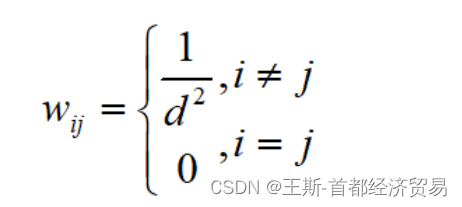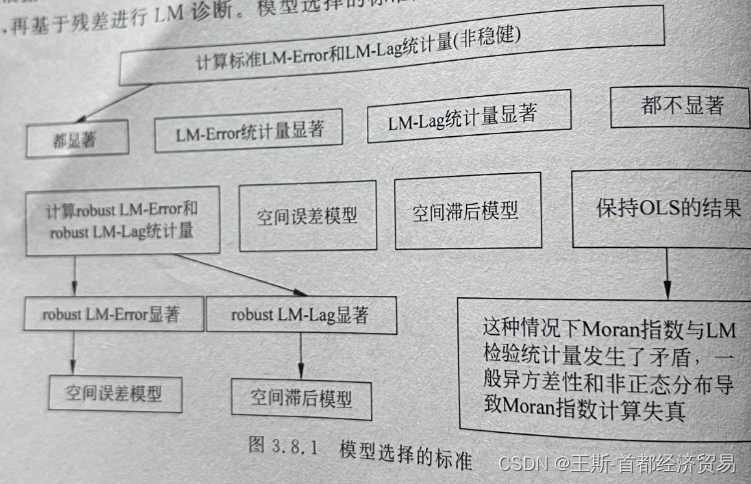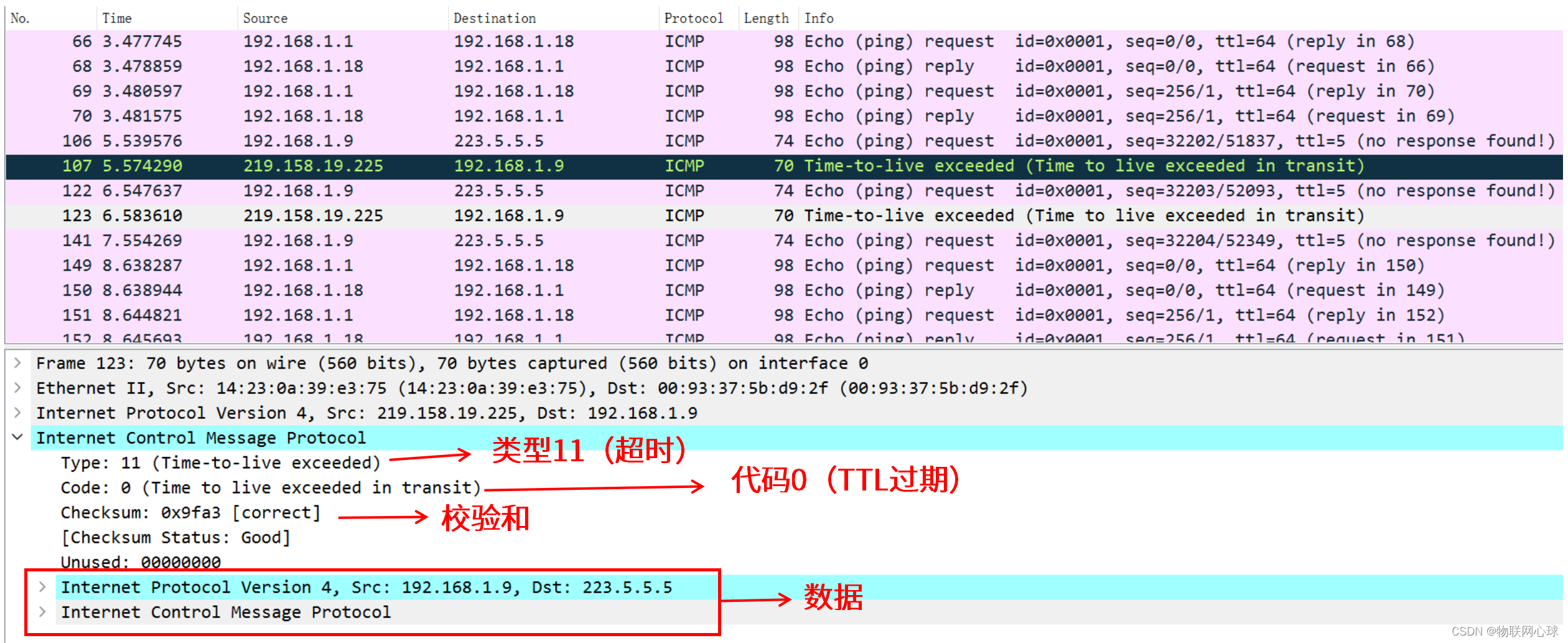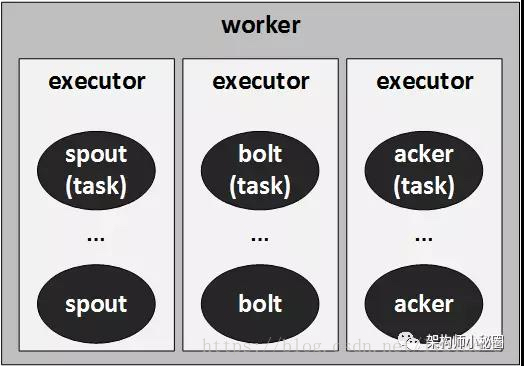让chatGPT使用Tensor flow Keras组装Bert,GPT,Transformer
- implement Transformer Model by Tensor flow Keras
- implement Bert model by Tensor flow Keras
- implement GPT model by Tensor flow Keras
本文主要展示Transfomer, Bert, GPT的神经网络结构之间的关系和差异。网络上有很多资料,但是把这个关系清晰展示清楚的不多。本文作为一个补充资料组织,同时利用chatGPT,让它使用Tensor flow Keras 来组装对应的迷你代码辅助理解。
从这个组装,可以直观的看到:
- Transformer: Encoder-Decoder 模块都用到了
- Bert: 只用到了Transformer的Encoder来作模块组装
- GPT: 只用到了Transformer的Decoder来做模块的组装
implement Transformer Model by Tensor flow Keras
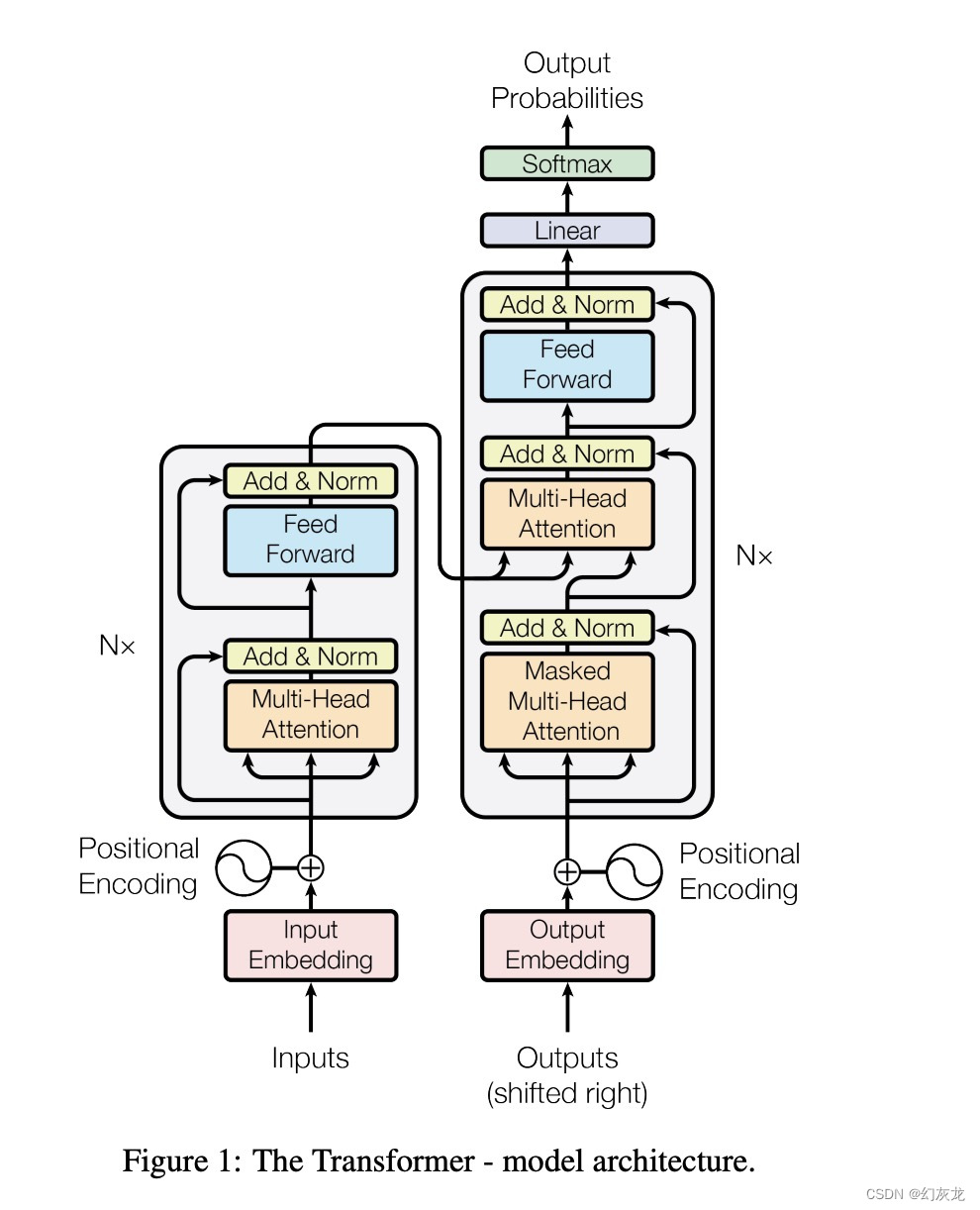
网上有大量讲解Transformer每层做什么的事情,这个可以单独一篇文章拆解我的理解。本文档假设在这点上读者已经理解了。
import tensorflow as tf
class Transformer(tf.keras.Model):
def __init__(self, num_layers, d_model, num_heads, d_ff, input_vocab_size, target_vocab_size, dropout_rate=0.1):
super(Transformer, self).__init__()
self.encoder = Encoder(num_layers, d_model, num_heads, d_ff, input_vocab_size, dropout_rate)
self.decoder = Decoder(num_layers, d_model, num_heads, d_ff, target_vocab_size, dropout_rate)
self.final_layer = tf.keras.layers.Dense(target_vocab_size)
def call(self, inputs, targets, enc_padding_mask, look_ahead_mask, dec_padding_mask):
enc_output = self.encoder(inputs, enc_padding_mask)
dec_output = self.decoder(targets, enc_output, look_ahead_mask, dec_padding_mask)
final_output = self.final_layer(dec_output)
return final_output
class Encoder(tf.keras.layers.Layer):
def __init__(self, num_layers, d_model, num_heads, d_ff, vocab_size, dropout_rate=0.1):
super(Encoder, self).__init__()
self.num_layers = num_layers
self.embedding = tf.keras.layers.Embedding(vocab_size, d_model)
self.positional_encoding = PositionalEncoding(vocab_size, d_model)
self.encoder_layers = [EncoderLayer(d_model, num_heads, d_ff, dropout_rate)
for _ in range(num_layers)]
self.dropout = tf.keras.layers.Dropout(dropout_rate)
def call(self, inputs, padding_mask):
embedded_input = self.embedding(inputs)
positional_encoded_input = self.positional_encoding(embedded_input)
encoder_output = self.dropout(positional_encoded_input)
for i in range(self.num_layers):
encoder_output = self.encoder_layers[i](encoder_output, padding_mask)
return encoder_output
class Decoder(tf.keras.layers.Layer):
def __init__(self, num_layers, d_model, num_heads, d_ff, vocab_size, dropout_rate=0.1):
super(Decoder, self).__init__()
self.num_layers = num_layers
self.embedding = tf.keras.layers.Embedding(vocab_size, d_model)
self.positional_encoding = PositionalEncoding(vocab_size, d_model)
self.decoder_layers = [DecoderLayer(d_model, num_heads, d_ff, dropout_rate)
for _ in range(num_layers)]
self.dropout = tf.keras.layers.Dropout(dropout_rate)
def call(self, inputs, encoder_output, look_ahead_mask, padding_mask):
embedded_input = self.embedding(inputs)
positional_encoded_input = self.positional_encoding(embedded_input)
decoder_output = self.dropout(positional_encoded_input)
for i in range(self.num_layers):
decoder_output = self.decoder_layers[i](decoder_output, encoder_output,
look_ahead_mask, padding_mask)
return decoder_output
class EncoderLayer(tf.keras.layers.Layer):
def __init__(self, d_model, num_heads, d_ff, dropout_rate=0.1):
super(EncoderLayer, self).__init__()
self.multi_head_attention = MultiHeadAttention(d_model, num_heads)
self.ffn = FeedForwardNetwork(d_model, d_ff)
self.layer_norm1 = tf.keras.layers.LayerNormalization(epsilon=1e-6)
self.layer_norm2 = tf.keras.layers.LayerNormalization(epsilon=1e-6)
self.dropout1 = tf.keras.layers.Dropout(dropout_rate)
self.dropout2 = tf.keras.layers.Dropout(dropout_rate)
def call(self, inputs, padding_mask):
attention_output = self.multi_head_attention(inputs, inputs, inputs, padding_mask)
attention_output = self.dropout1(attention_output)
attention_output = self.layer_norm1(inputs + attention_output)
ffn_output = self.ffn(attention_output)
ffn_output = self.dropout2(ffn_output)
encoder_output = self.layer_norm2(attention_output + ffn_output)
return encoder_output
class DecoderLayer(tf.keras.layers.Layer):
def __init__(self, d_model, num_heads, d_ff, dropout_rate=0.1):
super(DecoderLayer, self).__init__()
self.multi_head_attention1 = MultiHeadAttention(d_model, num_heads)
self.multi_head_attention2 = MultiHeadAttention(d_model, num_heads)
self.ffn = FeedForwardNetwork(d_model, d_ff)
self.layer_norm1 = tf.keras.layers.LayerNormalization(epsilon=1e-6)
self.layer_norm2 = tf.keras.layers.LayerNormalization(epsilon=1e-6)
self.layer_norm3 = tf.keras.layers.LayerNormalization(epsilon=1e-6)
self.dropout1 = tf.keras.layers.Dropout(dropout_rate)
self.dropout2 = tf.keras.layers.Dropout(dropout_rate)
self.dropout3 = tf.keras.layers.Dropout(dropout_rate)
def call(self, inputs, encoder_output, look_ahead_mask, padding_mask):
attention1_output = self.multi_head_attention1(inputs, inputs, inputs, look_ahead_mask)
attention1_output = self.dropout1(attention1_output)
attention1_output = self.layer_norm1(inputs + attention1_output)
attention2_output = self.multi_head_attention2(attention1_output, encoder_output, encoder_output, padding_mask)
attention2_output = self.dropout2(attention2_output)
attention2_output = self.layer_norm2(attention1_output + attention2_output)
ffn_output = self.ffn(attention2_output)
ffn_output = self.dropout3(ffn_output)
decoder_output = self.layer_norm3(attention2_output + ffn_output)
return decoder_output
class MultiHeadAttention(tf.keras.layers.Layer):
def __init__(self, d_model, num_heads):
super(MultiHeadAttention, self).__init__()
self.num_heads = num_heads
self.d_model = d_model
self.depth = d_model // num_heads
self.wq = tf.keras.layers.Dense(d_model)
self.wk = tf.keras.layers.Dense(d_model)
self.wv = tf.keras.layers.Dense(d_model)
self.dense = tf.keras.layers.Dense(d_model)
def split_heads(self, x, batch_size):
x = tf.reshape(x, (batch_size, -1, self.num_heads, self.depth))
return tf.transpose(x, perm=[0, 2, 1, 3])
def call(self, query, key, value, mask):
batch_size = tf.shape(query)[0]
q = self.wq(query)
k = self.wk(key)
v = self.wv(value)
q = self.split_heads(q, batch_size)
k = self.split_heads(k, batch_size)
v = self.split_heads(v, batch_size)
scaled_attention, attention_weights = scaled_dot_product_attention(q, k, v, mask)
scaled_attention = tf.transpose(scaled_attention, perm=[0, 2, 1, 3])
concat_attention = tf.reshape(scaled_attention, (batch_size, -1, self.d_model))
output = self.dense(concat_attention)
return output, attention
implement Bert model by Tensor flow Keras
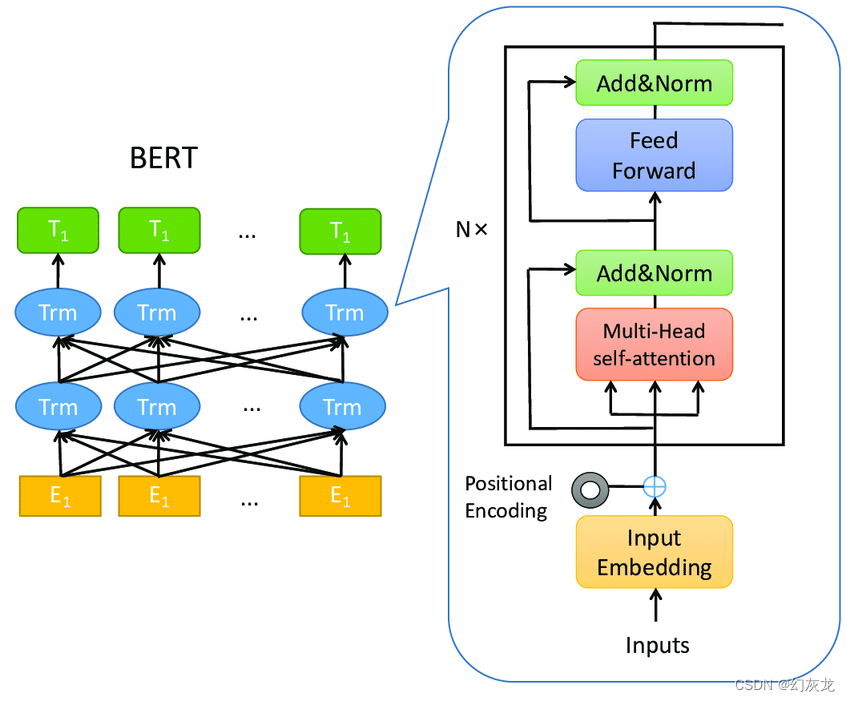
其中,左侧的每个Trm代表,右侧的放大图,也就是原始Transformer的Encoder部分结构。同时可以看到,Bert在左侧中,是双向组装Transformer的。Bert的训练任务包括MLM(Masked Language Model)和NSP(Next Sentence Prediction). Bert的训练是无监督的,因为MLM实际上就是将语料的某些Token遮挡起来,那么输出结果需要知道答案是什么(标注信息)实际上就包含在语料里。从这个角度来说,实际上也是监督的。
import tensorflow as tf
class BERT(tf.keras.Model):
def __init__(self, vocab_size, hidden_size, num_attention_heads, num_transformer_layers, intermediate_size):
super(BERT, self).__init__()
self.embedding = tf.keras.layers.Embedding(vocab_size, hidden_size)
self.transformer_layers = [TransformerLayer(hidden_size, num_attention_heads, intermediate_size)
for _ in range(num_transformer_layers)]
self.dropout = tf.keras.layers.Dropout(0.1)
def call(self, inputs, attention_mask):
embedded_input = self.embedding(inputs)
hidden_states = embedded_input
for transformer_layer in self.transformer_layers:
hidden_states = transformer_layer(hidden_states, attention_mask)
hidden_states = self.dropout(hidden_states)
return hidden_states
class TransformerLayer(tf.keras.layers.Layer):
def __init__(self, hidden_size, num_attention_heads, intermediate_size):
super(TransformerLayer, self).__init__()
self.attention = MultiHeadAttention(hidden_size, num_attention_heads)
self.feed_forward = FeedForward(hidden_size, intermediate_size)
self.layer_norm1 = tf.keras.layers.LayerNormalization(epsilon=1e-6)
self.layer_norm2 = tf.keras.layers.LayerNormalization(epsilon=1e-6)
self.dropout1 = tf.keras.layers.Dropout(0.1)
self.dropout2 = tf.keras.layers.Dropout(0.1)
def call(self, inputs, attention_mask):
attention_output = self.attention(inputs, inputs, inputs, attention_mask)
attention_output = self.dropout1(attention_output)
attention_output = self.layer_norm1(inputs + attention_output)
feed_forward_output = self.feed_forward(attention_output)
feed_forward_output = self.dropout2(feed_forward_output)
layer_output = self.layer_norm2(attention_output + feed_forward_output)
return layer_output
class MultiHeadAttention(tf.keras.layers.Layer):
def __init__(self, hidden_size, num_attention_heads):
super(MultiHeadAttention, self).__init__()
self.num_attention_heads = num_attention_heads
self.attention_head_size = hidden_size // num_attention_heads
self.query = tf.keras.layers.Dense(hidden_size)
self.key = tf.keras.layers.Dense(hidden_size)
self.value = tf.keras.layers.Dense(hidden_size)
self.dense = tf.keras.layers.Dense(hidden_size)
def call(self, query, key, value, attention_mask):
query = self.query(query)
key = self.key(key)
value = self.value(value)
query = self._split_heads(query)
key = self._split_heads(key)
value = self._split_heads(value)
attention_scores = tf.matmul(query, key, transpose_b=True)
attention_scores /= tf.math.sqrt(tf.cast(self.attention_head_size, attention_scores.dtype))
if attention_mask is not None:
attention_scores += attention_mask
attention_probs = tf.nn.softmax(attention_scores, axis=-1)
context_layer = tf.matmul(attention_probs, value)
context_layer = tf.transpose(context_layer, perm=[0, 2, 1, 3])
context_layer = tf.reshape(context_layer, (tf.shape(context_layer)[0], -1, hidden_size))
attention_output = self.dense(context_layer)
return attention_output
def _split_heads(self, x):
batch_size = tf.shape(x)[0]
length = tf.shape(x)[1]
x = tf.reshape(x, (batch_size, length, self.num_attention_heads,
implement GPT model by Tensor flow Keras
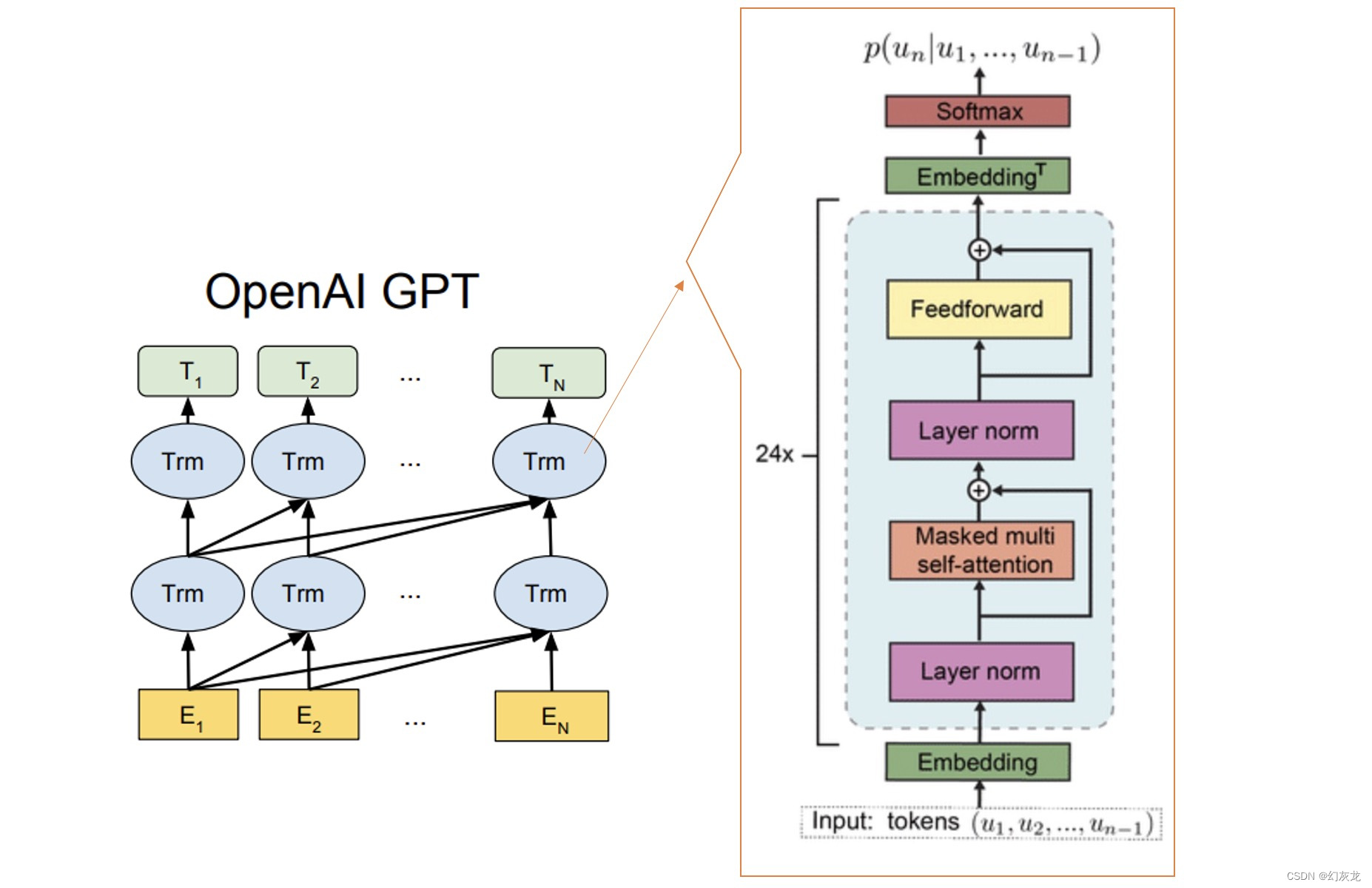
其中,左侧的每个Trm放大都是右侧的部分,也就是Transfomer原始结构里的Decoder部分。同时可以看到,GPT在左侧中,是单向组装Transformer的。GPT的训练任务就是生成下一个Token。GPT是无监督的,因为从机器学习的角度,输出数据需要的「标注信息」(下一个Token)就是语料已经提供的。从这个角度来说,其实也是监督的。
import tensorflow as tf
class GPT(tf.keras.Model):
def __init__(self, vocab_size, hidden_size, num_layers, num_heads, intermediate_size, max_seq_length):
super(GPT, self).__init__()
self.embedding = tf.keras.layers.Embedding(vocab_size, hidden_size)
self.positional_encoding = PositionalEncoding(max_seq_length, hidden_size)
self.transformer_blocks = [TransformerBlock(hidden_size, num_heads, intermediate_size)
for _ in range(num_layers)]
self.final_layer_norm = tf.keras.layers.LayerNormalization(epsilon=1e-6)
self.final_dense = tf.keras.layers.Dense(vocab_size, activation='softmax')
def call(self, inputs):
embedded_input = self.embedding(inputs)
positional_encoded_input = self.positional_encoding(embedded_input)
hidden_states = positional_encoded_input
for transformer_block in self.transformer_blocks:
hidden_states = transformer_block(hidden_states)
final_output = self.final_layer_norm(hidden_states)
final_output = self.final_dense(final_output)
return final_output
class TransformerBlock(tf.keras.layers.Layer):
def __init__(self, hidden_size, num_heads, intermediate_size):
super(TransformerBlock, self).__init__()
self.attention = MultiHeadAttention(hidden_size, num_heads)
self.feed_forward = FeedForward(hidden_size, intermediate_size)
self.layer_norm1 = tf.keras.layers.LayerNormalization(epsilon=1e-6)
self.layer_norm2 = tf.keras.layers.LayerNormalization(epsilon=1e-6)
def call(self, inputs):
attention_output = self.attention(inputs, inputs, inputs)
attention_output = self.layer_norm1(inputs + attention_output)
feed_forward_output = self.feed_forward(attention_output)
layer_output = self.layer_norm2(attention_output + feed_forward_output)
return layer_output
class MultiHeadAttention(tf.keras.layers.Layer):
def __init__(self, hidden_size, num_heads):
super(MultiHeadAttention, self).__init__()
self.num_heads = num_heads
self.attention_head_size = hidden_size // num_heads
self.query = tf.keras.layers.Dense(hidden_size)
self.key = tf.keras.layers.Dense(hidden_size)
self.value = tf.keras.layers.Dense(hidden_size)
self.dense = tf.keras.layers.Dense(hidden_size)
def call(self, query, key, value):
query = self.query(query)
key = self.key(key)
value = self.value(value)
query = self._split_heads(query)
key = self._split_heads(key)
value = self._split_heads(value)
attention_scores = tf.matmul(query, key, transpose_b=True)
attention_scores /= tf.math.sqrt(tf.cast(self.attention_head_size, attention_scores.dtype))
attention_probs = tf.nn.softmax(attention_scores, axis=-1)
context_layer = tf.matmul(attention_probs, value)
context_layer = tf.transpose(context_layer, perm=[0, 2, 1, 3])
context_layer = tf.reshape(context_layer, (tf.shape(context_layer)[0], -1, hidden_size))
attention_output = self.dense(context_layer)
return attention_output
def _split_heads(self, x):
batch_size = tf.shape(x)[0]
length = tf.shape(x)[1]
x = tf.reshape(x, (batch_size, length, self.num_heads, self.attention_head_size))
return tf.transpose(x, perm=[0, 2, 1, 3])
